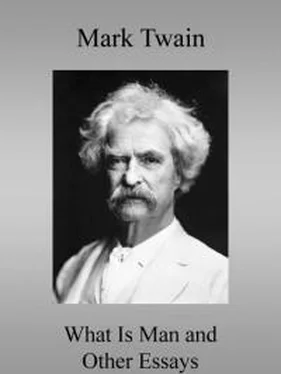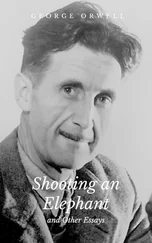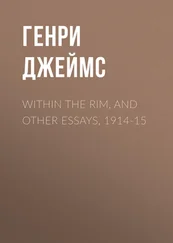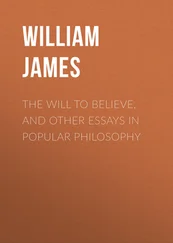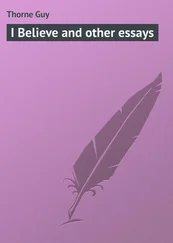Mark Twain - What Is Man? and Other Essays
Здесь есть возможность читать онлайн «Mark Twain - What Is Man? and Other Essays» весь текст электронной книги совершенно бесплатно (целиком полную версию без сокращений). В некоторых случаях можно слушать аудио, скачать через торрент в формате fb2 и присутствует краткое содержание. Жанр: Публицистика, на английском языке. Описание произведения, (предисловие) а так же отзывы посетителей доступны на портале библиотеки ЛибКат.
- Название:What Is Man? and Other Essays
- Автор:
- Жанр:
- Год:неизвестен
- ISBN:нет данных
- Рейтинг книги:4 / 5. Голосов: 1
-
Избранное:Добавить в избранное
- Отзывы:
-
Ваша оценка:
- 80
- 1
- 2
- 3
- 4
- 5
What Is Man? and Other Essays: краткое содержание, описание и аннотация
Предлагаем к чтению аннотацию, описание, краткое содержание или предисловие (зависит от того, что написал сам автор книги «What Is Man? and Other Essays»). Если вы не нашли необходимую информацию о книге — напишите в комментариях, мы постараемся отыскать её.
What Is Man? and Other Essays — читать онлайн бесплатно полную книгу (весь текст) целиком
Ниже представлен текст книги, разбитый по страницам. Система сохранения места последней прочитанной страницы, позволяет с удобством читать онлайн бесплатно книгу «What Is Man? and Other Essays», без необходимости каждый раз заново искать на чём Вы остановились. Поставьте закладку, и сможете в любой момент перейти на страницу, на которой закончили чтение.
Интервал:
Закладка:
This hen differs from the other one. He is on his way to inquire what has been happening in Canterbury.
How we arrive at Richard I., called Richard of the Lion- heart because he was a brave fighter and was never so contented as when he was leading crusades in Palestine and neglecting his affairs at home. Give him ten squares of WHITE paper. (Fig. 10).
That is a lion. His office is to remind you of the lion- hearted Richard. There is something the matter with his legs, but I do not quite know what it is, they do not seem right. I think the hind ones are the most unsatisfactory; the front ones are well enough, though it would be better if they were rights and lefts.
Next comes King John, and he was a poor circumstance. He was called Lackland. He gave his realm to the Pope. Let him have seventeen squares of YELLOW paper. (Fig. 11.)
That creature is a jamboree. It looks like a trademark, but that is only an accident and not intentional. It is prehistoric and extinct. It used to roam the earth in the Old Silurian times, and lay eggs and catch fish and climb trees and live on fossils; for it was of a mixed breed, which was the fashion then. It was very fierce, and the Old Silurians were afraid of it, but this is a tame one. Physically it has no representative now, but its mind has been transmitted. First I drew it sitting down, but have turned it the other way now because I think it looks more attractive and spirited when one end of it is galloping. I love to think that in this attitude it gives us a pleasant idea of John coming all in a happy excitement to see what the barons have been arranging for him at Runnymede, while the other one gives us an idea of him sitting down to wring his hands and grieve over it.
We now come to Henry III.; RED squares again, of course— fifty-six of them. We must make all the Henrys the same color; it will make their long reigns show up handsomely on the wall. Among all the eight Henrys there were but two short ones. A lucky name, as far as longevity goes. The reigns of six of the Henrys cover 227 years. It might have been well to name all the royal princes Henry, but this was overlooked until it was too late. (Fig. 12.)
This is the best one yet. He is on his way (1265) to have a look at the first House of Commons in English history. It was a monumental event, the situation in the House, and was the second great liberty landmark which the century had set up. I have made Henry looking glad, but this was not intentional.
Edward I. comes next; LIGHT-BROWN paper, thirty-five squares. (Fig. 13.)
That is an editor. He is trying to think of a word. He props his feet on a chair, which is the editor's way; then he can think better. I do not care much for this one; his ears are not alike; still, editor suggests the sound of Edward, and he will do. I could make him better if I had a model, but I made this one from memory. But is no particular matter; they all look alike, anyway. They are conceited and troublesome, and don't pay enough. Edward was the first really English king that had yet occupied the throne. The editor in the picture probably looks just as Edward looked when it was first borne in upon him that this was so. His whole attitude expressed gratification and pride mixed with stupefaction and astonishment.
Edward II. now; twenty BLUE squares. (Fig. 14.)
Another editor. That thing behind his ear is his pencil. Whenever he finds a bright thing in your manuscript he strikes it out with that. That does him good, and makes him smile and show his teeth, the way he is doing in the picture. This one has just been striking out a smart thing, and now he is sitting there with his thumbs in his vest-holes, gloating. They are full of envy and malice, editors are. This picture will serve to remind you that Edward II. was the first English king who was DEPOSED. Upon demand, he signed his deposition himself. He had found kingship a most aggravating and disagreeable occupation, and you can see by the look of him that he is glad he resigned. He has put his blue pencil up for good now. He had struck out many a good thing with it in his time.
Edward III. next; fifty RED squares. (Fig. 15.)
This editor is a critic. He has pulled out his carving- knife and his tomahawk and is starting after a book which he is going to have for breakfast. This one's arms are put on wrong. I did not notice it at first, but I see it now. Somehow he has got his right arm on his left shoulder, and his left arm on his right shoulder, and this shows us the back of his hands in both instances. It makes him left-handed all around, which is a thing which has never happened before, except perhaps in a museum. That is the way with art, when it is not acquired but born to you: you start in to make some simple little thing, not suspecting that your genius is beginning to work and swell and strain in secret, and all of a sudden there is a convulsion and you fetch out something astonishing. This is called inspiration. It is an accident; you never know when it is coming. I might have tried as much as a year to think of such a strange thing as an all-around left-handed man and I could not have done it, for the more you try to think of an unthinkable thing the more it eludes you; but it can't elude inspiration; you have only to bait with inspiration and you will get it every time. Look at Botticelli's "Spring." Those snaky women were unthinkable, but inspiration secured them for us, thanks to goodness. It is too late to reorganize this editor-critic now; we will leave him as he is. He will serve to remind us.
Richard II. next; twenty-two WHITE squares. (Fig. 16.)
We use the lion again because this is another Richard. Like Edward II., he was DEPOSED. He is taking a last sad look at his crown before they take it away. There was not room enough and I have made it too small; but it never fitted him, anyway.
Now we turn the corner of the century with a new line of monarchs—the Lancastrian kings.
Henry IV.; fourteen squares of YELLOW paper. (Fig. 17.)
This hen has laid the egg of a new dynasty and realizes the magnitude of the event. She is giving notice in the usual way. You notice I am improving in the construction of hens. At first I made them too much like other animals, but this one is orthodox. I mention this to encourage you. You will find that the more you practice the more accurate you will become. I could always draw animals, but before I was educated I could not tell what kind they were when I got them done, but now I can. Keep up your courage; it will be the same with you, although you may not think it. This Henry died the year after Joan of Arc was born.
Henry V.; nine BLUE squares. (Fig. 18)
There you see him lost in meditation over the monument which records the amazing figures of the battle of Agincourt. French history says 20,000 Englishmen routed 80,000 Frenchmen there; and English historians say that the French loss, in killed and wounded, was 60,000.
Henry VI.; thirty-nine RED squares. (Fig. 19)
This is poor Henry VI., who reigned long and scored many misfortunes and humiliations. Also two great disasters: he lost France to Joan of Arc and he lost the throne and ended the dynasty which Henry IV. had started in business with such good prospects. In the picture we see him sad and weary and downcast, with the scepter falling from his nerveless grasp. It is a pathetic quenching of a sun which had risen in such splendor.
Edward IV.; twenty-two LIGHT-BROWN squares. (Fig. 20.)
That is a society editor, sitting there elegantly dressed, with his legs crossed in that indolent way, observing the clothes the ladies wear, so that he can describe them for his paper and make them out finer than they are and get bribes for it and become wealthy. That flower which he is wearing in his buttonhole is a rose—a white rose, a York rose—and will serve to remind us of the War of the Roses, and that the white one was the winning color when Edward got the throne and dispossessed the Lancastrian dynasty.
Читать дальшеИнтервал:
Закладка:
Похожие книги на «What Is Man? and Other Essays»
Представляем Вашему вниманию похожие книги на «What Is Man? and Other Essays» списком для выбора. Мы отобрали схожую по названию и смыслу литературу в надежде предоставить читателям больше вариантов отыскать новые, интересные, ещё непрочитанные произведения.
Обсуждение, отзывы о книге «What Is Man? and Other Essays» и просто собственные мнения читателей. Оставьте ваши комментарии, напишите, что Вы думаете о произведении, его смысле или главных героях. Укажите что конкретно понравилось, а что нет, и почему Вы так считаете.
